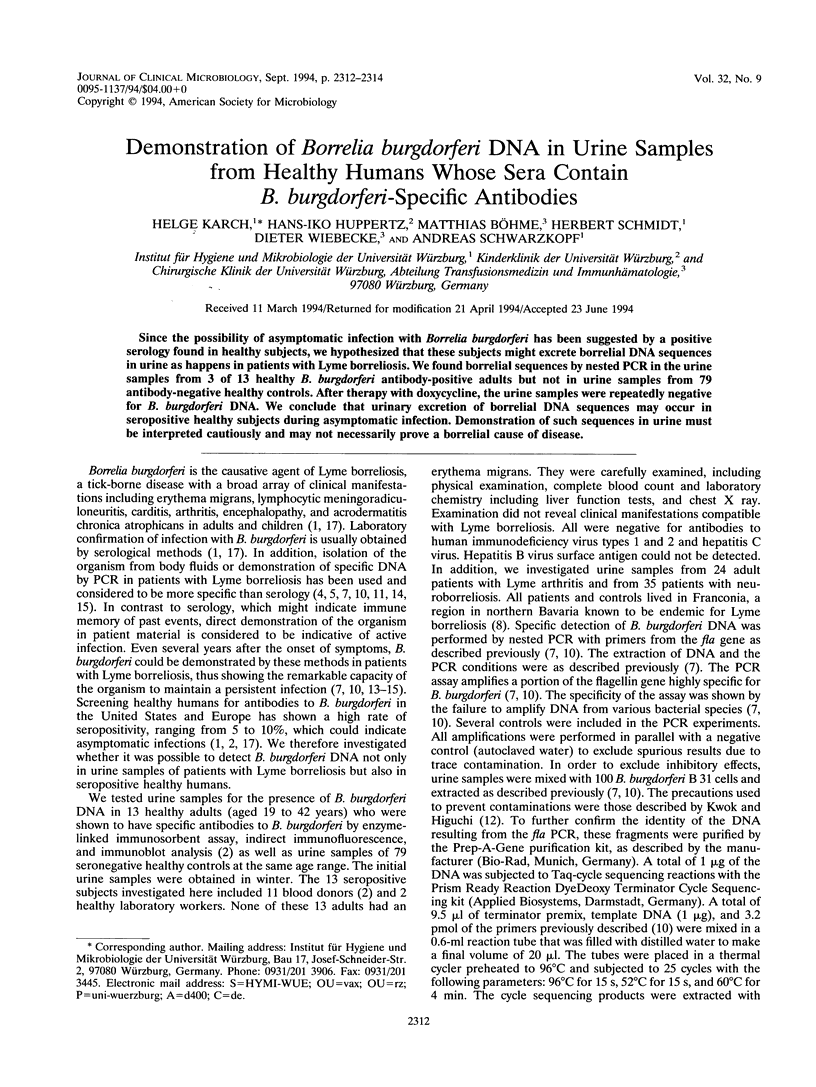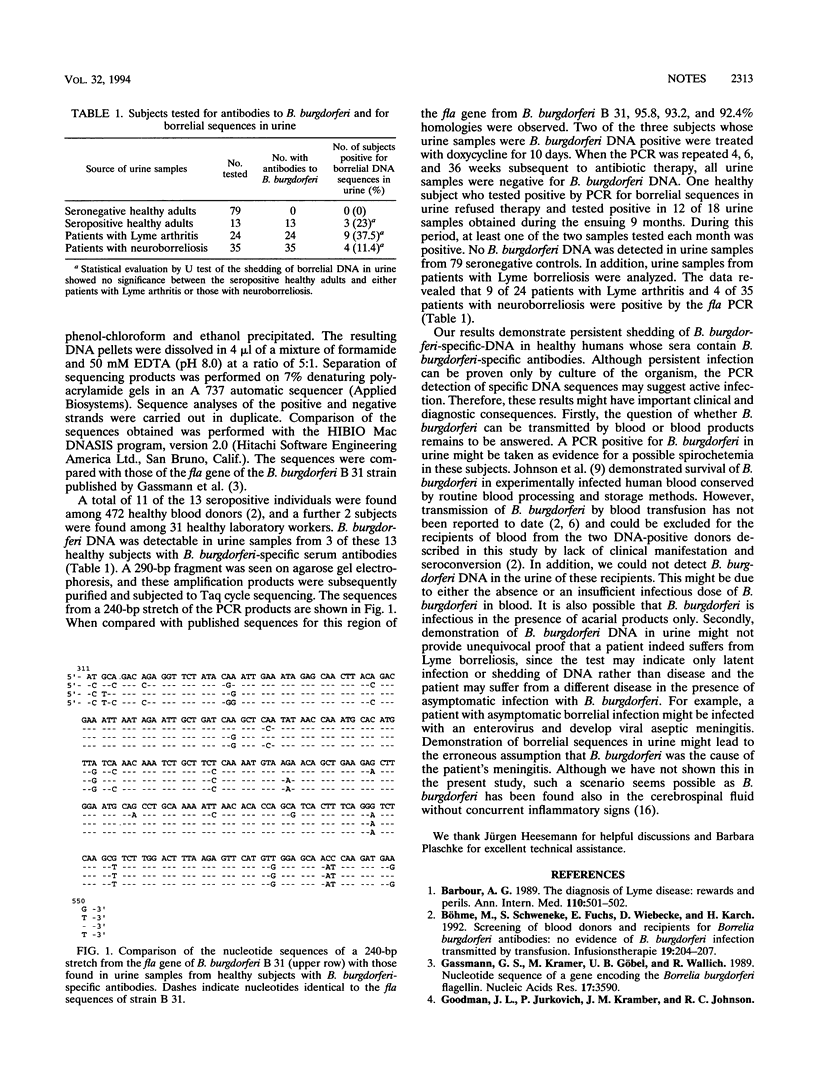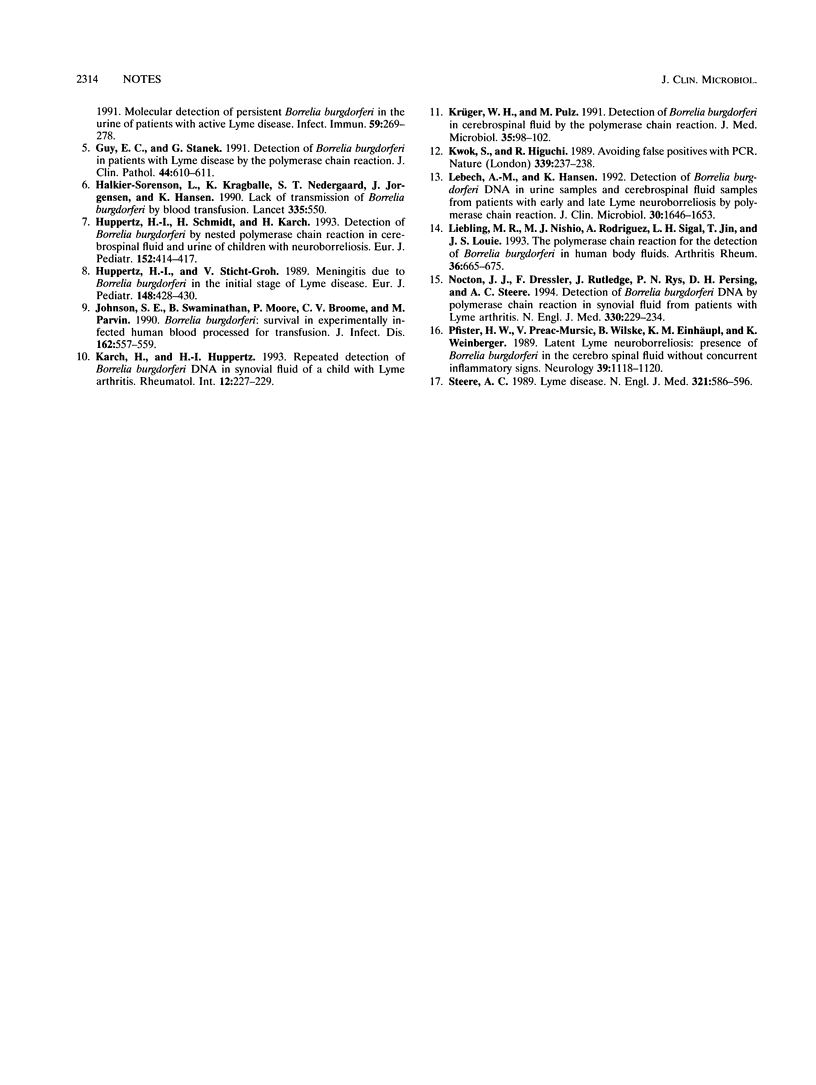Abstract
Since the possibility of asymptomatic infection with Borrelia burgdorferi has been suggested by a positive serology found in healthy subjects, we hypothesized that these subjects might excrete borrelial DNA sequences in urine as happens in patients with Lyme borreliosis. We found borrelial sequences by nested PCR in the urine samples from 3 of 13 healthy B. burgdorferi antibody-positive adults but not in urine samples from 79 antibody-negative healthy controls. After therapy with doxycycline, the urine samples were repeatedly negative for B. burgdorferi DNA. We conclude that urinary excretion of borrelial DNA sequences may occur in seropositive healthy subjects during asymptomatic infection. Demonstration of such sequences in urine must be interpreted cautiously and may not necessarily prove a borrelial cause of disease.
Full text
PDF


Selected References
These references are in PubMed. This may not be the complete list of references from this article.
- Barbour A. G. The diagnosis of Lyme disease: rewards and perils. Ann Intern Med. 1989 Apr 1;110(7):501–502. doi: 10.7326/0003-4819-110-7-501. [DOI] [PubMed] [Google Scholar]
- Böhme M., Schwenecke S., Fuchs E., Wiebecke D., Karch H. Screening of blood donors and recipients for Borrelia burgdorferi antibodies: no evidence of B. burgdorferi infection transmitted by transfusion. Infusionsther Transfusionsmed. 1992 Aug;19(4):204–207. doi: 10.1159/000222625. [DOI] [PubMed] [Google Scholar]
- Gassmann G. S., Kramer M., Göbel U. B., Wallich R. Nucleotide sequence of a gene encoding the Borrelia burgdorferi flagellin. Nucleic Acids Res. 1989 May 11;17(9):3590–3590. doi: 10.1093/nar/17.9.3590. [DOI] [PMC free article] [PubMed] [Google Scholar]
- Guy E. C., Stanek G. Detection of Borrelia burgdorferi in patients with Lyme disease by the polymerase chain reaction. J Clin Pathol. 1991 Jul;44(7):610–611. doi: 10.1136/jcp.44.7.610. [DOI] [PMC free article] [PubMed] [Google Scholar]
- Halkier-Sørensen L., Kragballe K., Nedergaard S. T., Jørgensen J., Hansen K. Lack of transmission of Borrelia burgdorferi by blood transfusion. Lancet. 1990 Mar 3;335(8688):550–550. doi: 10.1016/0140-6736(90)90790-c. [DOI] [PubMed] [Google Scholar]
- Huppertz H. I., Schmidt H., Karch H. Detection of Borrelia burgdorferi by nested polymerase chain reaction in cerebrospinal fluid and urine of children with neuroborreliosis. Eur J Pediatr. 1993 May;152(5):414–417. doi: 10.1007/BF01955900. [DOI] [PubMed] [Google Scholar]
- Huppertz H. I., Sticht-Groh V. Meningitis due to Borrelia burgdorferi in the initial stage of Lyme disease. Eur J Pediatr. 1989 Feb;148(5):428–430. doi: 10.1007/BF00595904. [DOI] [PubMed] [Google Scholar]
- Johnson S. E., Swaminathan B., Moore P., Broome C. V., Parvin M. Borrelia burgdorferi: survival in experimentally infected human blood processed for transfusion. J Infect Dis. 1990 Aug;162(2):557–559. doi: 10.1093/infdis/162.2.557. [DOI] [PubMed] [Google Scholar]
- Karch H., Huppertz H. I. Repeated detection of Borrelia burgdorferi DNA in synovial fluid of a child with Lyme arthritis. Rheumatol Int. 1993;12(6):227–229. doi: 10.1007/BF00301006. [DOI] [PubMed] [Google Scholar]
- Krüger W. H., Pulz M. Detection of Borrelia burgdorferi in cerebrospinal fluid by the polymerase chain reaction. J Med Microbiol. 1991 Aug;35(2):98–102. doi: 10.1099/00222615-35-2-98. [DOI] [PubMed] [Google Scholar]
- Kwok S., Higuchi R. Avoiding false positives with PCR. Nature. 1989 May 18;339(6221):237–238. doi: 10.1038/339237a0. [DOI] [PubMed] [Google Scholar]
- Lebech A. M., Hansen K. Detection of Borrelia burgdorferi DNA in urine samples and cerebrospinal fluid samples from patients with early and late Lyme neuroborreliosis by polymerase chain reaction. J Clin Microbiol. 1992 Jul;30(7):1646–1653. doi: 10.1128/jcm.30.7.1646-1653.1992. [DOI] [PMC free article] [PubMed] [Google Scholar]
- Liebling M. R., Nishio M. J., Rodriguez A., Sigal L. H., Jin T., Louie J. S. The polymerase chain reaction for the detection of Borrelia burgdorferi in human body fluids. Arthritis Rheum. 1993 May;36(5):665–675. doi: 10.1002/art.1780360514. [DOI] [PubMed] [Google Scholar]
- Nocton J. J., Dressler F., Rutledge B. J., Rys P. N., Persing D. H., Steere A. C. Detection of Borrelia burgdorferi DNA by polymerase chain reaction in synovial fluid from patients with Lyme arthritis. N Engl J Med. 1994 Jan 27;330(4):229–234. doi: 10.1056/NEJM199401273300401. [DOI] [PubMed] [Google Scholar]
- Pfister H. W., Preac-Mursic V., Wilske B., Einhäupl K. M., Weinberger K. Latent Lyme neuroborreliosis: presence of Borrelia burgdorferi in the cerebrospinal fluid without concurrent inflammatory signs. Neurology. 1989 Aug;39(8):1118–1120. doi: 10.1212/wnl.39.8.1118. [DOI] [PubMed] [Google Scholar]
- Steere A. C. Lyme disease. N Engl J Med. 1989 Aug 31;321(9):586–596. doi: 10.1056/NEJM198908313210906. [DOI] [PubMed] [Google Scholar]


